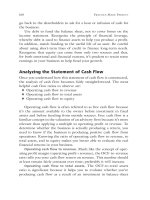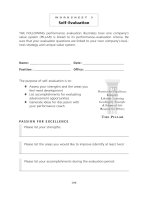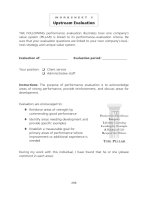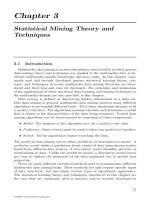Tài liệu Practice Made Perfect 3 pdf
Bạn đang xem bản rút gọn của tài liệu. Xem và tải ngay bản đầy đủ của tài liệu tại đây (97.95 KB, 10 trang )
! Prescribe some solutions
! Recommend behavioral change for long-term health
That done, you’re ready to proceed. Worksheet 1 in the appendix
can serve as a valuable tool as you assess the condition of your firm
in several key areas of practice management and determine where to
begin the work of transforming the practice you have into the one
you’ve always believed it could be.
XVI INTRODUCTION
Practice Made Perfect
This page is intentionally blank
I
F RUNNING A BUSINESS were easy, everybody would be doing
it. Managing a financial-advisory firm can be especially complex
because the business depends so much on people and, over time, is at
the mercy of events—from regulation to market swings—that can’t
be controlled. When these businesses start up, advisers are focused
on their own survival and can battle most of these challenges. But
as the financial-advisory business in general as well as the individ-
ual practices becomes more complex, advisers must anticipate and
respond to a myriad of challenges, including:
! A slower rate of organic growth caused by competition and mar-
ket returns
! Clients that are more demanding
! Difficulty in recruiting, retaining, and rewarding people
! An aversion to managing anything except their clients
! The pressure of margin squeeze
! The shrinkage of time
Slower Rate of Growth
The late 1990s created an illusion for a lot of people who invested in
the markets, including financial advisers, who witnessed extraordi-
nary rates of revenue growth tied to investable assets. This bonanza
made many of them feel brilliant, especially those who had the
wisdom to convert to a fee-based or fee-only model. However, the
market correction at the turn of the century and the modest returns
1
THE
FINANCIAL
ADVISORY
BUSINESS
The View from Here
1.
2 PRACTICE MADE PERFECT
projected for the foreseeable future have made revenue growth—
at least organic growth—more of a challenge.
Several conditions are conspiring against advisers who still hope
for rapid revenue growth:
1. Most experts predict long-term market rates of return of
below 8 percent.
2. Inflation remains at very low rates (although that could
change).
3. There is no longer an Internet bubble to give an artificial lift
to the markets—and consequently to fees.
4. Many advisers have already reached their capacity in terms of
the number of new clients they can add.
5. More pressure is likely on pricing, with new competition and
more demanding clients.
6. If a firm’s service offering is one-dimensional, justifying
higher fees is hard.
7. Many advisers lack a well-developed, systematic process for
marketing.
The good news, of course, is that challenge breeds opportunity.
There are things advisers can do, such as institutionalizing their
approach to business development and implementing a more rigid
client-acceptance process to maintain fee discipline. But it is impos-
sible—and imprudent—to ignore the weight the marketplace can
exert on top-line performance and on the rate of organic growth.
Clients Demanding More
The illusion that dazzled many advisers in the late 1990s afflicted
their clients as well. Clients grew confident of double-digit returns
and early retirement; they thought they had become risk tolerant (in
fact, they were only return tolerant), and their feedback to their advis-
ers was positive and glowing. As the markets corrected, though, and
returns dropped, many clients reacted with more needs, demands,
and requests, and they required significantly more handholding
and support from their advisers. For advisers charging fees based on
assets under management (AUM), fees declined at exactly the same
time that clients’ demands, needs, and expectations increased. Some
firms lost clients and felt the impact on their top line. Others kept
the clients, but felt the impact on their bottom line because they
needed to deliver more services for the same fee.
Difficulty in Recruiting and Retaining People
One of the most underdeveloped management muscles advisers have
is the one for managing and developing staff. Some love the task, but
most have neither the know-how nor the patience to do it well. Given
a choice of where to spend their time, advisers will universally choose
to be with clients rather than with staff. And since time is a finite
resource in every practice, it’s clear why staff development suffers.
The dilemma has a certain irony, considering that advisers are
generally good “people” persons, meaning that they’re generally
empathetic, nurturing, encouraging, and fair in their judgment of
clients—almost to a fault. Yet many of them struggle to employ
these same qualities when dealing with their own staff. Part of the
problem may lie in a perception that staff is a cost to be managed and
controlled, rather than an asset that can generate a return. When the
perception shifts from a cost-based view to an asset-based one, advis-
ers begin treating their staff as one of their top clients, which has the
potential to create substantial income and value for the practice.
Aversion to Management
In his excellent book The E Myth: Why Most Businesses Don’t Work
and What to Do About It (HarperCollins, 1985), Michael Gerber
identified traits of the typical entrepreneur. Most were technicians,
and many had worked for someone else before starting their own
businesses. With the creation of their own enterprises, they were
able to assert their independence, but they still viewed the business
through the eyes of a technician. Financial advisers could be the
poster children for The E Myth.
The joy of business ownership does not always come from build-
ing something but rather from owning something independent of
any boss. For many, the desire is to keep all elements of a practice
THE FINANCIAL ADVISORY BUSINESS: THE VIEW FROM HERE 3
4 PRACTICE MADE PERFECT
within arm’s reach. So although their sandbox may be small, the
point is it’s their sandbox. Adding people, processes, protocols, and
other disciplines to the management of this enterprise takes all the
fun out of being independent.
The problem is that good advisers naturally attract more business.
In fact, many have such a well-honed skill for developing clients that
they can’t help but grow. The dilemma is the more clients they add,
the more staff they must add; the more staff they add, the more
technology they must add; the more the business grows, the more
their span of control expands beyond their reach. But does that stop
them from growing?
Not really. There is a fundamental belief in the advisory world
that “more clients solve all problems.” Obviously, the inflow has
to exceed the outflow, or your upkeep will be your downfall, but
business success does not depend on income alone. If you fly at top
speed, you run out of fuel that much sooner.
Successful advisers recognize that their business is their primary
client: it’s the generator of wealth and the cornerstone of their estate.
Although the aversion to management may be natural, an attraction
may grow if advisers look at it from that perspective. For advisory
firms, success is defined by quality client service, ethical conduct,
and the highest standard of unbiased, objective advice. Assuming
these forces are in place, it’s also important to define success from a
business perspective—that is, as revenue growth, consistent profit-
ability, a fair return or compensation for the owner, a healthy bal-
ance sheet, and value that’s transferable. Without physical capacity,
it’s hard to sustain this definition of success.
That said, the solo model is a viable option for many, as long as
they don’t want to grow. The problem is most successful advisers
can’t help themselves. They do things to enhance their reputation,
raise their visibility, and please their clients, which in turn results
in more referrals. More referrals beget more business, which
forces the adviser to add staff to serve them. Those who are com-
mitted to the solo solution should read David Drucker and Joel
Bruckenstein’s Virtual-Office Tools for a High-Margin Practice
(Bloomberg Press, 2002) to learn how to manage the technology.
But if staying solo or small is not an option, then advisers must
work on improving their approach to the recruitment, retention,
and development of staff and to the ongoing management of the
business.
Margin Squeeze
During the market downturn, speculation was afoot that fees for
asset management would be under severe pressure, with projected
reductions of as much as 25 to 40 basis points. Some advisers have
adjusted their fees because they lack the confidence to ask a fair price
for the services they provide to their clients, but the reality is that
few advisory firms have had to adjust their fees much. More typical
of what’s happening is that advisers are providing more services to
clients for the same fees they charged several years ago. So although
margins are not necessarily getting squeezed from the top as a result
of fee pressure, they’re typically getting squeezed from the bottom
as a result of the increase in expenses required to generate the same
level of fees.
Management of gross margin is probably the single most impor-
tant discipline that an adviser can apply to his or her practice, as
we’ll discuss in chapter 8 on financial management. Not only is it
important to manage costs; it’s also important to know when pricing,
productivity, and client mix are dragging down the enterprise.
Time Squeeze
Advisor Impact, a practice-management consulting firm in Toronto,
did a study of the practice-management behaviors of financial advis-
ers. In a question examining where the typical adviser spends his or
her time, the results showed that only 39 percent of advisers’ time is
spent on client service. The rest of their time is spent on other tasks,
like business processing and administration.
One reason time is so elusive for many advisers is that they’re
doing things they shouldn’t be doing and have no one to whom
to delegate work. Even those who put adequate staff in place may
maintain a death grip on the processes and on the client relationships
because they’re not comfortable relinquishing control.
THE FINANCIAL ADVISORY BUSINESS: THE VIEW FROM HERE 5
6 PRACTICE MADE PERFECT
With his highly successful Strategic Coach process, Dan Sullivan
has introduced many advisers to the concept of focusing on their
unique abilities. But it’s hard for anyone to give up what’s com-
fortable and familiar and delegate appropriate work to others.
Complicating time management, of course, is the general anxiety
that small-business owners experience in not taking every piece of
business that comes in the door. But one adviser can handle only
a finite number of clients. Our studies show that advisers who call
themselves wealth managers—meaning they deal with myriad com-
plex issues beyond investment strategy and implementation—can
handle no more than sixty to ninety active client relationships. But
if only 39 percent of their time is available to spend on client man-
agement, how many clients can they handle effectively?
The combination of client selection, process improvement, and
effective delegation will mitigate the time-squeeze problem, but hav-
ing the courage to live by such discipline is another matter. Service
businesses have only two things to sell: expertise and time. But when
time is not properly managed, it’s like watching your inventory walk
out the door.
The Top Ten Challenges of Advisory Firms
To validate these assumptions about advisory firms, each year we ask
advisers to tell us their top challenges as business owners. The top
ten haven’t changed for ten years, although the order in which they
appear changes from year to year:
1. Lack of capacity to serve clients
2. Building value in the practice
3. Improving efficiency
4. Getting better clients
5. Managing growth
6. Offering value-added services
7. K ee pi ng p a ce w it h te c h n o lo g y
8. Developing specific expertise internally
9. Maintaining a life outside of the business
10. Time management
THE FINANCIAL ADVISORY BUSINESS: THE VIEW FROM HERE 7
As consultants, whenever we observe a chronic problem, we try
to find a permanent solution. But such solutions can work only when
the owners of practices are willing to commit to changing their
behavior. The problem is analogous to the problems advisers face
working with certain clients. You calculate their retirement needs
and evaluate their risk-management needs. In the simplest terms, the
only two things they need to do are save enough money to invest and
purchase insurance to mitigate their exposure. But what if they’re
committed to buying a new truck each year and to spending any
excess cash on dinners out? At what point will they realize that the
closer they are to retirement, the farther away they are from a solu-
tion? For an advisory firm, the same is true. The longer the practice
takes to invest in processes, protocols, and people, the greater the
likelihood that it will not flourish. So as an advisory firm begins
thinking strategically about its future, it’s helpful to understand
where it is in its life cycle.
The Practice Life Cycle
Financial-advisory firms—like people—go through a life cycle. They
are born, they grow, they mature, and they pass on. We jokingly refer
to these stages of the life cycle as “wonder, blunder, thunder, and
plunder” (see Figure 1.1). We borrowed this clever phrasing from
Leon Danco, one of the leading visionaries on business-owner suc-
cession, who long ago wrote two outstanding books on the subject:
Inside the Family Business (Center for Family Business, 1982) and
Beyond Survival: A Guide for Business Owners and Their Families
(Center for Family Business, 1975).
The challenge for advisers is to eventually align their personal life
cycle with their business life cycle. Consider each stage:
Wonder. In this phase, practitioners are usually brimming with
optimism, although some proceed with trepidation. Their practice-
management style is seat-of-the-pants; they have no profits, no cash;
and their clients look pretty much like they do. During this period,
anyone who can fog a mirror is a prospect. If they’re related, they
become a client. The adviser focuses on volume of business just to
survive.









